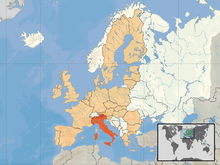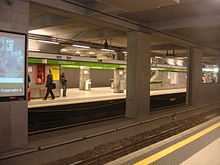Transport in Italy

Italy has well developed public and private transportation options. Italian rail network is extensive, especially in the north, generally eclipsing the need for an alternative such as bus or air (both of which, however, exist to some extent). While a number of private railroads exist and provide mostly commuter-type services, the national railway, Ferrovie dello Stato, also provides sophisticated high-speed rail service that joins the major cities of Italy from Naples through northern cities such as Milan and Turin. Italy has 2507 people and 12.46 km2 (World's seventh) per km of rail track.[1]
Italy's road network is also widespread, with a total length of about 487,700 km.[2] It comprises both an extensive motorway network (6,400 km), mostly toll roads, and national and local roads.
Because of its long seacoast, Italy also has a large number of harbors for the transportation of both goods and passengers. Italy has been a seafaring peninsula dating back to the days of the Etruscans and the Greeks.
Railways

Italian railway system has a length of 19,394 km (12,051 mi), of which 18,071 km (11,229 mi) standard gauge and 11,322 km (7,035 mi) electrified. The active lines are 16,723 km.[3] The network is recently growing with the construction of the new high-speed rail network. The narrow gauge tracks are:
- 112 km (70 mi) of 1,000 mm (3 ft 3 3⁄8 in) gauge (all electrified);
- 1,211 km (752 mi) of 950 mm (3 ft 1 3⁄8 in) gauge (of which 153 km (95 mi) electrified)
Most of the Italian rail network is managed and operated by Ferrovie dello Stato, a state owned company. Other railway companies, mostly owned by public entities such as Regions, operate on the Italian network, generally on regional services.
Travelers who will be using the railway often during their stay in Italy might use Rail Passes, some of them can be used also in other European countries. With these passes, options are available for the number of days travelers will be using the pass within a two-month period. There are also saver passes for adults who will always be traveling together during their trip, which can save up to 20% on the passes. Foreign travelers should purchase these passes far enough in advance to allow for shipping to a home address before traveling to Italy. When using these passes dates need to be filled in for the day they are being used before boarding the trains. High speed trains require seat reservations which can be obtained at the ticket offices. Regional trains, however, do not require seat reservations and a properly filled out rail pass will suffice as a ticket.[4]
High speed trains
High-speed rail in Italy currently consists of two lines connecting all the country's major cities. The first line connects Milan to Salerno via Bologna, Florence, Rome and Naples, the second runs from Turin to Venice via Milan, and is under construction in parts. The network is designed for a top speed of over 300 km/h (190 mph).
Service is provided by Trenitalia and, since 2012, by NTV, the first private operator of high-speed trains.
Rapid transit
Cities with metro systems:
| City | Name | Lines | Length (km) | Stations | Opening |
|---|---|---|---|---|---|
| Brescia | Brescia Metro | 1 | 13.7 | 17 | 2013 |
| Catania | Catania Metro | 1 | 4 | 6 | 1999 |
| Genoa | Genoa Metro | 1 | 7.1 | 8 | 1990 |
| Milan | Milan Metro | 4 | 92 | 101 | 1964 |
| Naples | Naples Metro[5] | 2 | 15.8 | 19 | 1993 |
| Rome | Rome Metro | 3 | 53.4 | 67 | 1955 |
| Turin | Turin Metro | 1 | 13.2 | 21 | 2006 |
Cities with commuter rail systems:
- Bari (Bari metropolitan railway service)
- Milan (Milan suburban railway service)
- Naples, 5 lines
- Palermo (Palermo metropolitan railway service)
- Rome, 8 lines (FR lines)
- Salerno (Salerno metropolitan railway service)
- Turin (Turin Metropolitan Railway Service)
Rail links with adjacent countries

Italy's main railroad passenger carrier, Trenitalia, operates trains linking Italy to France, Switzerland, Austria and Slovenia. Other companies, like Cisalpino (owned by Trenitalia and SBB), Rhätische Bahn and SNCF operate international links. Vatican City is also linked with a railroad, occasionally used.[6] San Marino used to have a narrow gauge rail connection with Italy, dismantled in 1944.[7]
Stations

Italy's top ten railway stations by annual passengers are:
| Station | passengers per year (million) |
|---|---|
| Bologna Centrale | 58 |
| Firenze Santa Maria Novella | 59 |
| Genova Piazza Principe | 24 |
| Milano Centrale | 120 |
| Napoli Centrale | 50 |
| Roma Termini | 150 |
| Torino Porta Nuova | 70 |
| Venezia Mestre | 31 |
| Venezia Santa Lucia | 30 |
| Verona Porta Nuova | 25 |
Stations with darker background are also served by High-speed trains
Roads



Italy is one of the countries with the most vehicles per capita, with 690 per 1000 people in 2010.[8][9] Italy has a total of 487,700 km of paved roads, of which 6,700 km are motorways generally with a speed limit of 130 km/h (81 mph). The speed limit in towns is usually 50 km/h (31 mph) and less commonly 30 km/h (19 mph).
Waterways
Italy has 2,400 km (1,491 mi) of navigable waterways for various types of commercial traffic, although of limited overall value.[10]
Ports and harbours
| List of ports in Italy |
|---|
| Busiest ports by cargo tonnage in Italy (2008)[11] | Busiest ports by passengers in Italy (2008)[11] | ||||||||||||||||||||||||||||||||||||||||||||||||||||||||||||||||||||||||||||||||||||||||||||||||||||||||||||||||||||||||||||||||||||||||||||||||
|---|---|---|---|---|---|---|---|---|---|---|---|---|---|---|---|---|---|---|---|---|---|---|---|---|---|---|---|---|---|---|---|---|---|---|---|---|---|---|---|---|---|---|---|---|---|---|---|---|---|---|---|---|---|---|---|---|---|---|---|---|---|---|---|---|---|---|---|---|---|---|---|---|---|---|---|---|---|---|---|---|---|---|---|---|---|---|---|---|---|---|---|---|---|---|---|---|---|---|---|---|---|---|---|---|---|---|---|---|---|---|---|---|---|---|---|---|---|---|---|---|---|---|---|---|---|---|---|---|---|---|---|---|---|---|---|---|---|---|---|---|---|---|---|---|---|
|
|
Airports
Italy is the fifth in Europe by number of passengers by air transport, with about 148 million passengers or about 10% of the European total in 2011.[12] Most of passengers in Italy are on international flights (57%). A big share of domestic flights connect the major islands (Sardinia and Sicily) to the mainland.[12] Domestic flights between major Italian cities as Rome and Milan still play a relevant role but are declining since the opening of the Italian high-speed rail network in recent years.
Italy has a total as of 130 airports in 2012, of which 99 have paved runways:[10]
- over 3,047 m: 9
- 2,438 to 3,047 m: 31
- 1,524 to 2,437 m: 18
- 914 to 1,523 m: 29
- under 914 m: 12
Airports - with unpaved runways in 2012:[10]
- total: 31
- 1,524 to 2,437 m: 1
- 914 to 1,523 m: 11
- under 914 m: 19
Busiest airports

This is a list of the top ten busiest airports in Italy in 2009.[13]
| Airport | Movements | Passengers | Freight (tons) | ||||
|---|---|---|---|---|---|---|---|
| disembarked | embarked | total | disembarked | embarked | total | ||
| Rome Fiumicino | 311,679 | 16,150,965 | 16,294,531 | 32,445,496 | 64,069 | 72,001 | 136,070 |
| Milan Malpensa | 169,389 | 7,946,725 | 7,885,436 | 15,832,161 | 159,687 | 167,382 | 327,069 |
| Milan Linate | 92,884 | 4,160,526 | 4,130,569 | 8,291,095 | 7,972 | 8,532 | 16,504 |
| Venice Marco Polo | 67,160 | 3,220,072 | 3,216,922 | 6,436,994 | 12,511 | 13,005 | 25,516 |
| Bologna Guglielmo Marconi | 53,022 | 2,117,111 | 2,124,922 | 4,242,033 | 6,920 | 8,887 | 15,807 |
| Naples Capodichino | 52,367 | 2,406,886 | 2,426,418 | 4,833,304 | 1,935 | 1,142 | 3,077 |
| Bergamo Orio al Serio | 52,120 | 3,310,447 | 3,325,468 | 6,635,915 | 4,597 | 4,951 | 9,548 |
| Catania-Fontanarossa | 50,503 | 2,768,158 | 2,794,629 | 5,562,787 | 5,229 | 3,204 | 8,433 |
| Palermo Punta Raisi | 46,182 | 2,089,904 | 2,071,786 | 4,161,690 | 1,618 | 1,656 | 3,274 |
| Turin Caselle | 42,649 | 1,494,395 | 1,494,981 | 2,989,376 | 794 | 625 | 1,419 |
| Other | 333,181 | 15,470,588 | 15,507,497 | 30,978,085 | 37,396 | 32,991 | 70,387 |
| Total | 1,271,136 | 61,135,777 | 61,273,159 | 122,408,936 | 302,728 | 314,376 | 617,104 |
See also
References
- ↑ Compare List of countries by rail transport network size.
- ↑ CIA World Factbook 2005
- ↑ "La rete oggi". RFI Rete Ferroviaria Italiana. Retrieved 15 November 2011.
- ↑ http://www.italiarail.com/rail-passes
- ↑ Metronapoli lines
- ↑ "La Ferrovia dello Stato della Città del Vaticano" (in Italian). Sala stampa della Santa Sede. Retrieved 9 January 2012.
- ↑ "la "Ferrovia Rimini - San Marino"" (in Italian). www.ferroviedismesse.com. Retrieved 6 January 2012.
- ↑ John Sousanis (15 August 2011). "World Vehicle Population Tops 1 Billion Units". Ward AutoWorld. Retrieved 27 August 2011.
- ↑ See also: List of countries by vehicles per capita
- ↑ 10.0 10.1 10.2 "Italy". The World Factbook. CIA. Retrieved 8 January 2012.
- ↑ 11.0 11.1 "Graduatoria dei porti italiani". Istat. Retrieved 9 January 2012.
- ↑ 12.0 12.1 "Trasporto aereo in Italia (PDF)". ISTAT. Retrieved 5 August 2013.
- ↑ "Trasporto aereo 2003–2009". Istat. Retrieved 9 January 2012.
External links
![]() Media related to Transport in Italy at Wikimedia Commons
Media related to Transport in Italy at Wikimedia Commons
| ||||||||||||||||||||||||||||||||||||||||||||
| ||||||||||||||||||